The U.S. Coast Guard at Normandy
by Scott T. Price
Click here to download a PDF version of this article.
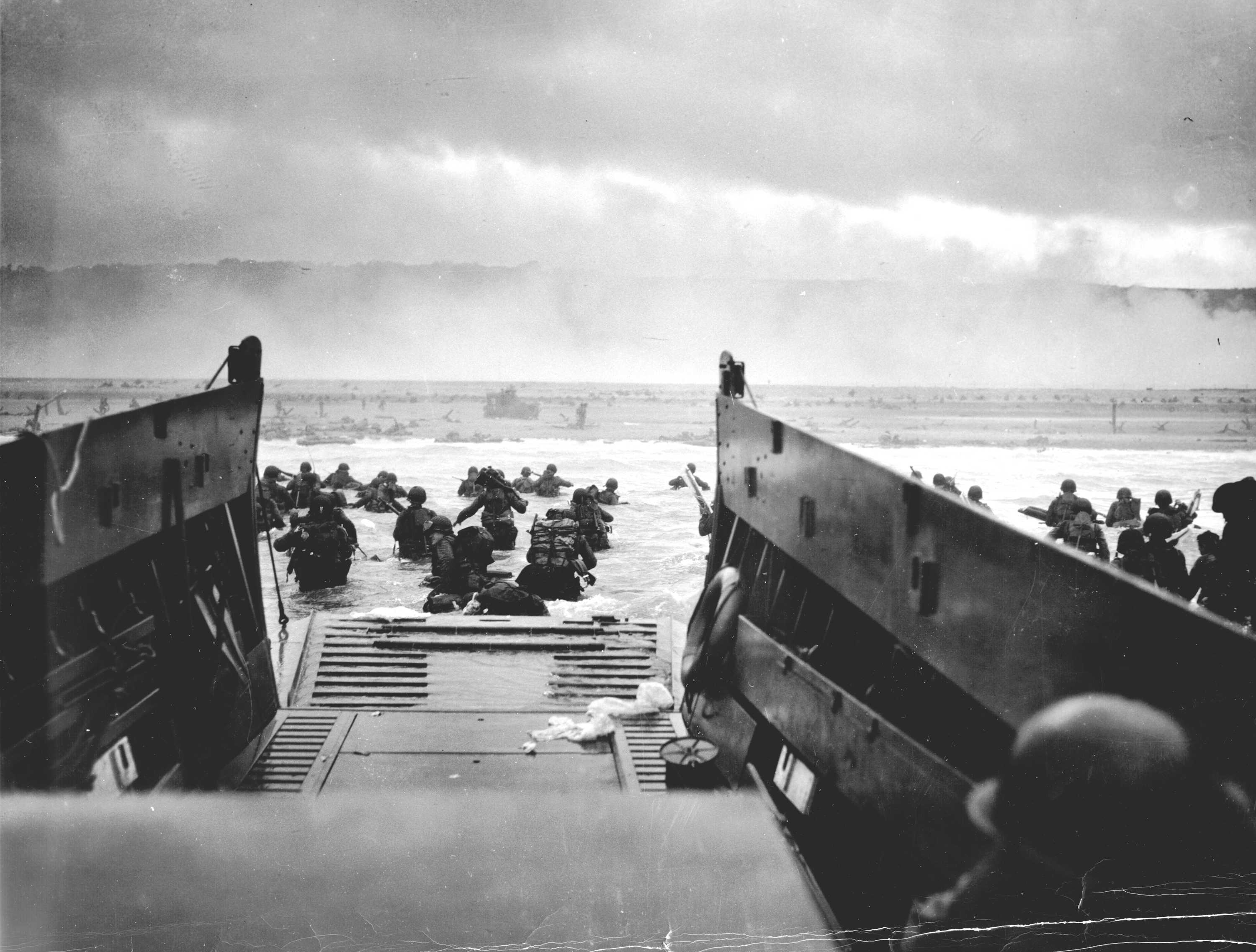
"The Jaws of Death" - An official U.S. Coast Guard photograph by CPHOM Robert F. Sargent, USCG. A Coast Guard-manned LCVP from the U.S.S. Samuel Chase disembarks U.S. troops on the morning of 6 June 1944 at Omaha Beach.
[190415-G-G0000-7001]
The Coast Guard-manned landing craft LCI(L)-85 approached the beach at 12 knots. Her crew winced as they heard repeated thuds against the vessel's hull made by the wooden stakes covering the beach like a crazy, tilted, man-made forest.
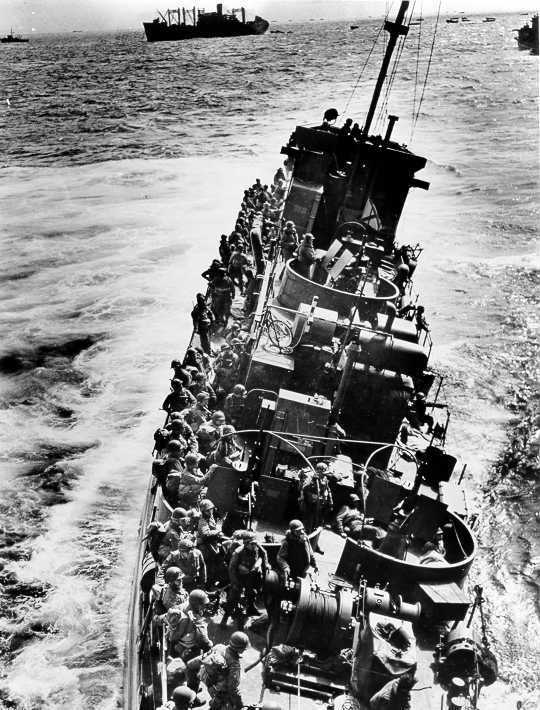
The Coast Guard LCI(L)-85, battered by enemy fire after approaching Omaha Beach, prepares to evacuate the troops she was transporting to an awaiting transport. The "85" sank shortly after this photograph was taken. The LCI(L)-85 was one of four Coast Guard LCI's that were destroyed on D-Day.
[190415-G-G0000-7002]
No clear channel existed where the commanding officer's charts indicated there would be, so he ordered the landing craft straight through the obstacles that had been covered by the incoming tide. The bow soon touched bottom, and as the ship ground to a halt, so did its luck. A mine exploded and ripped a gaping hole in the forward compartments, and then German batteries pummeled the LCI. Many of the troops on board were torn to pieces before they ever got off the ship. Those who were still able to disembark could not, because the explosions had destroyed the vessel's landing ramps.
The burning LCI backed off the beach as the crew fought the fires in the forward compartments. The ship then began to list as water poured in through the shell holes. Other landing craft approached to take off the uninjured troops while other crewmembers manned the sinking landing craft's pumps in a vain attempt to keep the vessel afloat. Then the crew sailed back to the transport area as the ship's list became more and more pronounced. They stayed with the listing LCI and managed to offload the wounded on to the Coast Guard-manned attack-transport USS Samuel Chase before they had to abandon their ship. The waters of Normandy washed over the blood-stained decks as the LCI settled deeper. She then capsized, exposing the bottom of her battered hull to the sky and now threatened to become a hazard to navigation to the thousands of ships and craft milling about the area. The crew of a salvage vessel took care of the problem by placing a mine in her hull and exploded it to force her to the sea floor, a final, ignominious end for a gallant veteran that had made so many successful combat landings against hostile shores. Slowly, as the water filled her hull, she turned her stern skyward and sank. The LCI(L)-85 was one of the many Coast Guard-manned ships that participated in the landings in France on June 6, 1944 - a day that would prove to be one of the bloodiest in the Coast Guard's long history.
The 88's began hitting the ship, they tore into the compartments and exploded on the exposed deck. Machine guns opened up. Men were hit and men were mutilated. There was no such thing as a minor wound.
Lieutenant, Junior Grade Coit Hendley, USCGR, commanding officer of USS LCI(L)-85, describing in his official Action Report what happened when his vessel approached Omaha Beach on the morning of D-Day.
Fifty years ago, U.S., British, Canadian and French forces invaded Adolf Hitler's Fortress Europe in an operation code-named Overlord. The Supreme Allied Commander, General Dwight D. Eisenhower, called it a "Great Crusade." The Coast Guard, along with the Army, Navy and Army Air Force participated in the crusade's onset, the greatest amphibious operation the world had ever seen. In August 1943, at the Quebec Conference the combined chiefs of staff agreed to mount an invasion of France in 1944. When finalized the plan called for the landing of five divisions along the French coast at Normandy. In addition, two divisions of paratroopers were to be dropped behind the coastline to help isolate the frontline German troops. Eisenhower was appointed the commander of Supreme Headquarters, Allied Expeditionary Force, known as SHAEF. He set the invasion date, D-Day, for June 5, 1944, when tidal and moon conditions would be most favorable.
Neptune was the code name given to Overlord's amphibious assault and naval gunfire support operations. These operations were divided between two task forces that would get the troops from ports all over Great Britain and land them on the beaches of Normandy, keep them supplied, and give them fire support. The Western Naval Task Force, under the command of Navy Rear Admiral Alan Kirk, transported the U.S. First Army to the American assault areas code named Utah and Omaha. The Eastern Naval Task Force, commanded by Royal Navy Rear Admiral Sir Philip Vian, landed the British Second Army on assault areas to the east of the American landings, code-named Gold, Juno and Sword.
The U.S. Coast Guard was an integral part of Operation Neptune. The service's presence centered around Assault Group "O-1" that landed troops of the famous First Division, the "Big Red One," on the easternmost beaches of the Omaha assault area. Commanded by Coast Guard Captain Edward H. Fritzsche, this assault group consisted of the Samuel Chase, the United States Navy's USS Henrico, the Royal Navy's HMS Empire Anvil, six LCI(L)s, six LSTs, and 97 smaller craft.
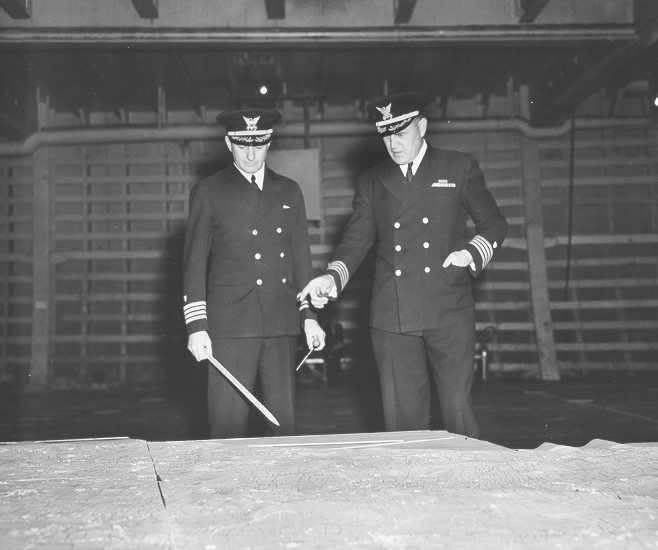
Unsung heroes Coast Guard Captains Edward Fritzche (left) and Miles Imlay (right) discuss the invasion of Omaha Beach on a relief map laid out in the hold of the Samuel Chase.
[190415-G-G0000-7003]
The deputy assault commander of Assault Group O-1 was another Coast Guard combat veteran, Captain Miles Imlay, who doubled as the commander of the Coast Guard manned LCI(L) Flotilla 10. Flotilla 10 was a veteran flotilla, as they had landed troops under fire during the invasions of both Sicily and Salerno. The battle-tested landing craft of Flotilla 10 were divided between the Omaha and Utah landing forces. Assault Group O-1 proved to be the largest Coast Guard command of Neptune but it was not the only.
Further west from the Omaha beaches was the Utah assault area. Navy Rear Admiral Don P. Moon commanded this assault from the Coast Guard-manned attack transport USS Bayfield. Designated the force flagship, the Bayfield was commanded by Coast Guard Captain Lyndon Spencer and served as the nerve center for the entire Utah assault. Among the other vessels that landed the Fourth Infantry Division at Utah were the Coast Guard-manned USS Joseph T. Dickman, the USS Barnett, which had a partial Coast Guard crew, and the HMS Empire Gauntlet.
The Coast Guard participated in the British and Canadian landings as well. Four Coast Guard-manned LSTs trained with and carried British troops and equipment to the landings at Gold, Juno and Sword. The Coast Guard also partially manned many U.S. Navy vessels including the transport USS Charles Carroll. Beyond providing leadership and men to crew U.S. Navy vessels, the Coast Guard also provided the Allied fleet with cutters of its own.
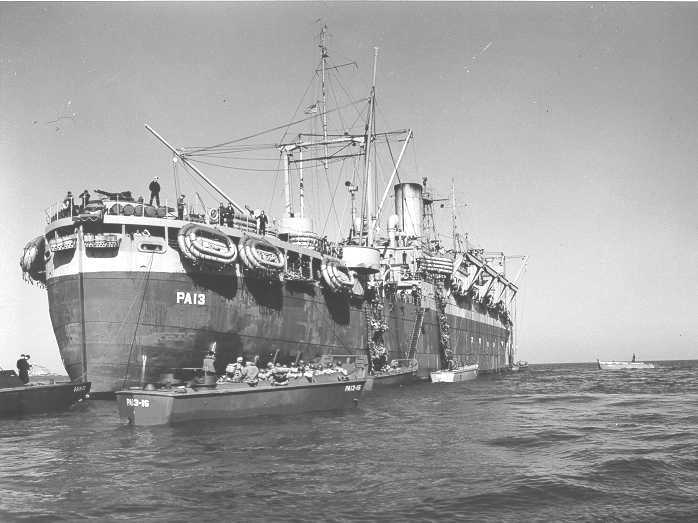
The Coast Guard-manned assault transport USS Joseph T. Dickman.
[190416-G-G0000-1001]

The Coast Guard-manned assault transport USS Bayfield, flagship of the Utah Beach invasion forces.
[190416-G-G0000-1002]
A few weeks prior to D-Day, President Franklin D. Roosevelt suggested that Operation Neptune needed a rescue flotilla. Since resources were stretched to the limit the Commander in Chief, U.S. Fleet and Chief of Naval Operations, Admiral Ernest J. King, USN, looked to the service dedicated to life saving at sea. The Coast Guard had 83-foot patrol boats, nicknamed the "matchbox fleet," on anti-submarine duty along the East Coast of the United States. Although they were constructed of wood and had gasoline engines, hence the nickname, they were available and had trained crews. King ordered 60 of them to New York harbor where they were hastily put aboard freighters and shipped to England.
Renamed Rescue Flotilla One for the invasion, it was commanded by Coast Guard Reserve Commander Alexander Stewart. Each patrol boat was assigned a hull number sequentially from one to 60 to aid in identification, and SHAEF planners ordered half of the patrol boats to sail in support of the Eastern Naval Task Force while the other half sailed with Kirk's command.
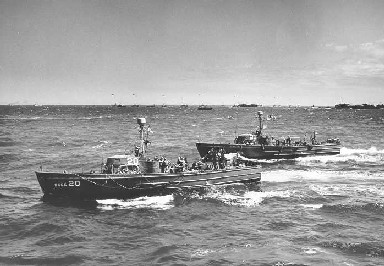
The 83-foot cutters 83401, renamed USCG 20, and the 83402, renamed USCG 21, were two of the sixty Coast Guard cutters sent to England to serve as rescue craft off each of the invasion beaches during the Normandy Invasion.
[190416-G-G0000-1003]
While Allied bombers continued to bomb targets in Northern Europe and battle the Luftwaffe in preparation for Normandy, Navy RADM John L. Hall, commander of the Omaha assault force, supervised the training of all Navy and Coast Guard sailors. Hall established joint amphibious schools where landing-craft crews were trained in small boat handling, ship-to-shore movement, and beach landings and retractions. They also received training in beach-party operations, beach markings, salvage and general maintenance. Coast Guardsmen and Navy sailors also trained together in joint exercises with the army assault troops.
They practiced small-scale landings along the British coast and made five full-scale practice assaults at Slapton Sands, whose beaches were similar to those at Normandy. Imlay's Flotilla 10 participated in many of the exercises as did most of the Coast Guard-manned LSTs and transports. The intense training, combined with the experience gained during the invasions in the Mediterranean, was critical to ensuring a successful landing of troops and supplies on the beaches.
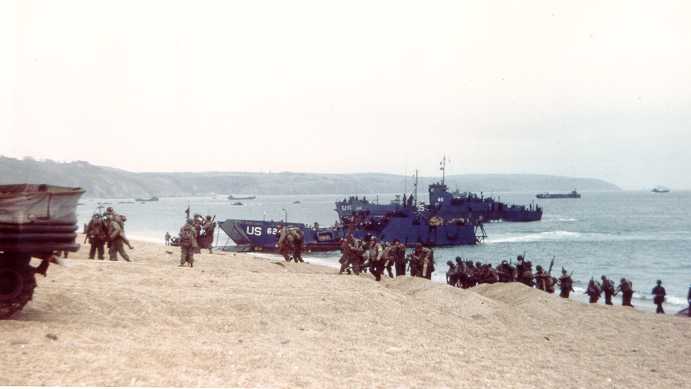
Coast Guard-manned LCI(L)-85 during a practice landing at Slapton Sands. The "85" would be pummeled by enemy fire during the invasion and sank in the English Channel on D-Day.
[190416-G-G0000-7001]
While the Allies prepared to assault Fortress Europe, the Germans prepared to throw them back into the sea. In November 1943, Hitler turned to his most trusted army general, Field Marshal Erwin Rommel, nicknamed by his admiring British enemy as the "Desert Fox," to inspect and improve German defenses from Denmark to the Spanish border. Here, the man who nearly drove the British out of North Africa energetically went to work inspecting the "Atlantic Wall."
At every stop Rommel urged the troops to greater effort. When one officer told Rommel that he was working the men too hard, the Desert Fox snapped, "Which would your men rather be, tired, or dead?" To strengthen the defenses he devised a number of sinister devices that would tear the bottom off a landing craft or wreck a glider. These included sharpened wood poles that the Germans nicknamed "Rommel's asparagus" and a more lethal trap of three steel bars welded together that came to be known as "hedgehogs." Behind these beach obstacles the Germans placed 4 million mines, dug bunkers, built concrete pillboxes and flooded fields.
Which would your men rather be, tired, or dead?
Field Marshal Erwin Rommel extorts an officer to work his men harder in building Hitler's "Atlantic Wall".
Although formidable, Allied intelligence kept a close watch on the German preparations and noted two oversights. First, as expected, the defenses were concentrated around the Pas de Calais, France, well away from Normandy. Second, the beach obstacles along the coast were set to repel an invasion at high tide and as such they lay exposed during low tide. It was not until May that Rommel realized his error and ordered them extended past the low tide mark. But it would take time to add the extra obstacles.
The planners at SHAEF took advantage of these oversights by setting up a phantom army, under the command of George Patton, whom the Germans believed would command the invasion. The planners included bogus radio traffic and dummy vehicles placed at Dover, Great Britain, directly across from Pas de Calais, to reinforce the German conviction that the invasion would land there. They also scheduled H-Hour, the time of the first landings, to begin one hour after low tide, when all of the obstacles would be exposed and therefore easier to destroy.
Underway on the "Great Crusade"
On May 28, the crews were "sealed" aboard their vessels, and the troops were kept within their camps. The heavily-laden soldiers began loading into their water-borne taxis on Friday, June 2. They would be aboard for nearly three days before D-Day and to combat sea-sickness each soldier was provided with motion sickness pills and bags which the Army listed as, appropriately, "Bag, vomit, one." They would be needed.
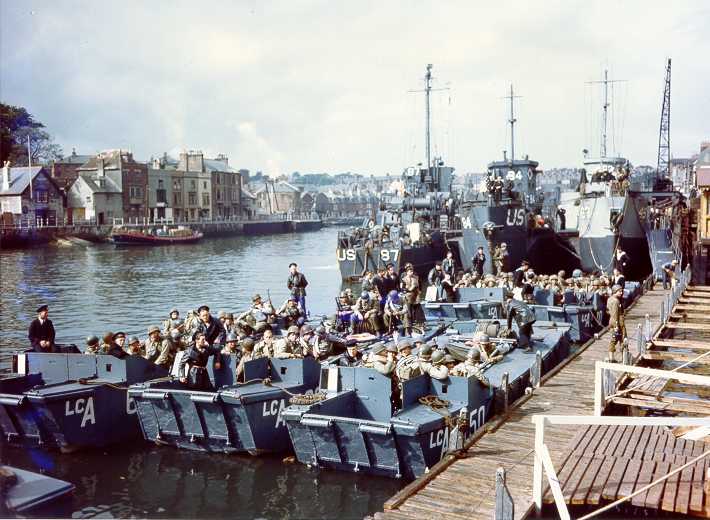
Coast Guard Flotilla 10 tied up in the background along with British landing craft, prepare to sail the English Channel and invade Nazi-occupied France. These landing craft landed U.S. troops on Omaha Beach.
[190416-G-G0000-7002]
During the cramped weekend, the troops managed to stay busy cleaning their weapons, writing letters or just resting while their Coast Guard, Navy and the British Royal Navy hosts prepared their ships for the channel crossing. The invasion fleet restlessly sortied from their British ports on June 4, but the weather worsened to the point that Eisenhower postponed the invasion for 24 hours. The ships returned to their harbors.
Early on Monday, June 5, Eisenhower attended a conference with Allied meteorologists. They predicted that the weather would partially clear for two days and then worsen. If they postponed the invasion again it would be nearly two weeks before the tide and moon conditions would be right. He thought for a moment and then at 4:15 a.m. looked up and said, "OK, We'll go."
Under the partially-obscured June moon the Coast Guard attack transports Bayfield and Joseph T. Dickman departed Plymouth harbor in England and formed up with the rest of the Utah assault force at a rendezvous point nicknamed the "Piccadilly Circus." The crews could see the Coast Guard 83-foot cutters form up along the convoy's outskirts and they heard the thundering formations of thousands of Allied aircraft overhead. The convoy traversed the lighted-buoy channels while an 18-knot westerly wind raced across the waters of the English Channel.
In the transports, the men who would man and pilot the assault craft filled with troops through rough seas, enemy fire and underwater obstacles received their final instructions. Just like their comrades aboard the LCIs, they studied highly-detailed relief maps and memorized landmarks that would guide them to their assigned landing areas. They had trained hard for Neptune and many were veterans of previous landings but their responsibilities still lay hard with them. It was their job to get the soldiers to the beaches in order for the invasion and liberation of Europe to succeed; the assault troops were useless unless they made it ashore in a condition to fight.

Bound for Normandy, U.S. Army troops on board a Coast Guard-manned LCI(L), during the night of 5 June 1944.
[190416-G-G0000-7003]
Utah Beach
The Bayfield dropped anchor in the transport area 11 miles from the coast at 2:30 a.m., June 6. Over the ship's loudspeakers the troops heard the ominous words "Now hear this. Stand by, all troops." Soon they were clamoring down cargo nets into the pitching and heaving LCMs and with a grunt and a puff of smoke from the diesel engines the landing craft were off towards the coast of France. The Joseph T. Dickman ordered boats away at 3:53 a.m. Unloading went off without a hitch despite the rough seas and soon its boats were off to Utah through mine-swept channels.
Now hear this. Stand by, all troops.
What the personnel aboard the troopship Bayfield heard over the ship's loudspeaker at 0230 on the morning of June 6, 1944.
The heavy seas cascaded over the hulls and blunt bows of the landing craft, drenching the troops aboard. One Coast Guard sailor said, "We were cold and soaked to the skin even before we started on our 11-mile trip shoreward, as a choppy sea broke over our square bow." The American landing craft had bilge pumps but the British did not and those soldiers aboard kept busy bailing with their helmets. But regardless of the type of craft, everyone got wet.
Life on the flat bottomed LCI(L)s was not pleasant either. The sailors joked that "LCI" stood for "Lousy Civilian Idea" but had long since become accustomed to their pitch and roll.

Coast Guard LCI(L)-350, one of the veteran landing vessels of Coast Guard Flotilla 10, a veteran of the invasion of Sicily, Salerno, and Normandy.
[190416-G-G0000-1004]
But the soldiers had not, and the rough seas did not make their journey any easier. Some wolfed down their motion sickness pills and became drowsy but most just got seasick. In fact, seasickness was rampant throughout the invasion forces that night. While the rough seas made life for the Allied troops miserable, they ironically proved to be a blessing.
The poor weather convinced the German navy and army commands that the Allies would not be able to launch an invasion. The German naval commander ordered all vessels to stay in port, while Rommel traveled back to Germany on Sunday, June 4, to celebrate his wife's birthday and then visit Hitler. He was sure that the invasion was not imminent. The German air force was almost non-existent near Normandy anyway and so there were no reconnaissance flights to detect the armada as it left Great Britain. The Allies achieved total surprise.
The landing craft of the Utah assault soon passed the warships of the gunfire support squadron at their station 11,000 yards off the landing area. At 5:30 a.m., they opened fire on German gun emplacements. The Utah landing area was a gentle sloping beach backed by sand dunes on the Cotentin Peninsula south of Cherbourg, France. The German defenses here included 28 heavy batteries of fixed 210mm artillery and a large number of deadly mobile 88mm guns.
The proposed landing area was divided into two sections, code named Beach Red and Beach Green. Two Navy control vessels guided the landing craft and a number of amphibious tanks from an assembly point into their respective beaches.
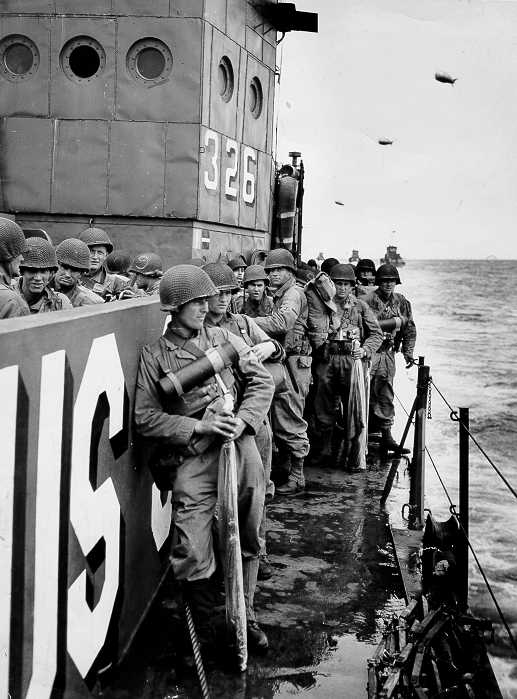
LCI(L)-326 en route to Utah Beach of D-Day.
[190416-G-G0000-7004]
Despite the meticulous planning, confusion reigned on Utah beach. Beach Red's control ship struck a mine and sank. The relatively featureless beaches, further obscured by naval gunfire and rocket explosions, and the nearly 11-mile trip in from the transport, area all combined to confuse the remaining control vessels and landing craft.
As a result, the first wave of landing craft discharged their troops 1,500 yards further south than planned. What otherwise could have turned out to be a disastrous turn of events actually proved to be fortuitous. There were fewer obstacles and no German heavy-gun emplacements at this landing site. Brigadier General Theodore Roosevelt Jr., the son of President Theodore Roosevelt, came ashore with the first wave and determined the error. After careful consideration he ordered the invasion to commence "right here." The second wave, carrying the underwater demolition squads, moved in and they quickly went to work destroying the exposed obstacles while the infantry fought their way inland.
With channels to both beaches cleared, the landings commenced in earnest. The landing craft, continually exposed to enemy gunfire, dodged sunken obstacles and sailed through the heavy seas, shuttling between the landing areas and the transports bringing desperately needed supplies and reinforcements right to the beaches. Both transports and their landing craft successfully disembarked their troops, equipment and ammunition on schedule. The training and professionalism of both Coast Guard-manned transports were responsible for that effort. Nevertheless, they did take losses. Although all of the Bayfield's landing craft returned, seven of the Dickman's did not. Three swamped in the heavy surf and four were sunk by artillery fire.
After their human cargo was offloaded the transports' job was not finished. Each had well-equipped sick bays that saw great use during D-Day. Many of the wounded soldiers and sailors owed their lives to the corpsmen and the U.S. Public Health Service doctors aboard the Coast Guard-manned transports. Sixty-three wounded came aboard the Dickman before it weighed anchor and sailed back to Plymouth. The Bayfield, as the command ship, remained off Utah, while its doctors treated the wounded and its radios buzzed with messages from and to the beaches.
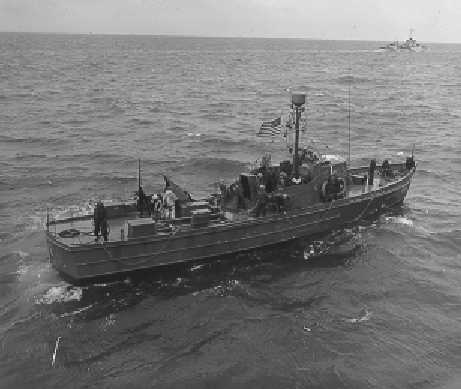
Coast Guard Rescue Flotilla One's "USCG 1" off Normandy.
[190416-G-G0000-1005]
The patrol boats from the matchbox fleet had a hectic and dangerous morning. Unlike the troops who could seek shelter, they, along with the assault boat crews, braved enemy fire and obstacles time and again from H-Hour through the rest of the day. Originally, most were to remain near the transports, but it soon became evident that they would be needed close ashore.
The 83-foot CGC-16, nick-named the "homing pigeon" arrived off the beachhead prior to the invasion and began picking up survivors from disabled landing craft in the assembly area at 5:30 a.m. Throughout the morning, the vessel's crew pulled 90 soldiers and sailors from the water. By 9:30 a.m., after administering first aid to the wounded, the crew transferred the survivors to the Dickman. By the end of the day they had pulled 126 men from the English Channel, the largest number saved by any of the Coast Guard matchbox-fleet craft that day.
Gold, Juno & Sword
Meanwhile, along the Allies' left flank four Coast Guard LSTs and 29 cutters from the matchbox fleet accompanied the British and Canadian assaults at Gold, Juno and Sword. One cutter had mechanical problems and was unable to make the trip across the Channel until later in the month. The four Coast Guard-manned LSTs safely delivered their troops and cargo as their allies attempted to take the town of Caen. Although the LSTs got along well with their British cousins, the cutters had some difficulties. The HMS Hind almost opened fire on four 83-foot craft when they attempted to join their convoy. Other British commanders were not sure how best to use the cutters and ordered them to stand by a cruiser where they milled about during the invasion and then returned to Britain. The CGC-24 stood by the HMS Albatross for two days and acted as a courier, including "fetching an officer's pipe" and transporting personnel. Despite these minor SNAFUs, most of the cutters were well used and spent the day pulling British and Canadian soldiers and sailors from the channel.
...fetching an officer's pipe
What a crew of one cutter, assigned to the British invasion forces, did on D-Day, according to their official Action Report.
The CGC-35 traversed the channel in support of 24 Royal Navy LCI(L)s and followed the first wave in to the Sword landing area at 7:40 a.m.
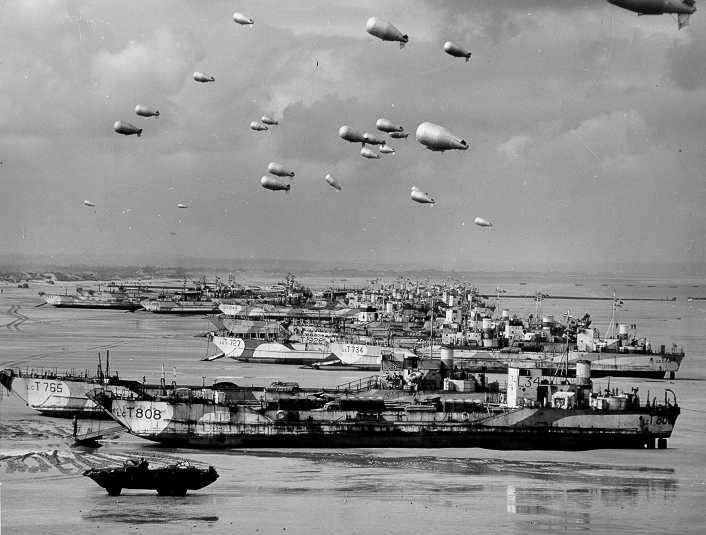
British LCT's line the Normandy shore, each with a barrage balloon designed to discourage enemy air attack.
[190416-G-G0000-7005]
The cutter sailed to a burning craft, and rescued five survivors. Unable to transfer them to a transport because of the heavy seas, the crew made the survivors comfortable below and returned to their patrol station. The CGC-34 pulled 32 British soldiers and seamen from the channel on D-Day. The CGC-53 took station off the beaches and soon thereafter the crew rescued five men from a swamped landing craft and came under fire from German shore batteries. The crew watched as the battleship HMS Rodney opened fire and silenced the Germans before they proceeded back to Britain.
The cutters assigned to the Eastern Naval Task Force ably lived up to the Coast Guard's tradition of saving lives at sea and the Coast Guard LSTs also distinguished themselves in support of their allies. Fortunately, no Coast Guard vessels were lost off the British beaches on D-Day, but the same was not true at Omaha.
Omaha Beach
A bad omen opened the action at Omaha that morning when just before H-Hour, 480 Eighth Air Force-heavy bombers released their deadly cargo in an effort to silence the German defenders. Unfortunately, because of heavy cloud cover and a desire not to hit the approaching landing craft, they released late and the bombs fell three miles inland. With the German defenses in place and manned, the Americans would have a bloody morning.
The beaches at the Omaha assault area were ideally situated for defense. Rocky cliffs and sandy bluffs framed the booby-trapped beaches which were 300-yards long at low tide. The bluffs gave excellent fields of fire and with the high ground the defenders could fire down into approaching landing craft.
The Germans embellished every advantage nature provided. They built eight large concrete bunkers, 35 smaller pillboxes with artillery, anti-tank, and machine-gun positions; six mortar pits; and 35 rocket-launching sites. The German soldiers, including men of the veteran 352nd Division whom the assault troops did not know were there, had dug 85 machine-gun nests which held the entire beach in a crossfire. In front of these troops, covering the beaches, were Rommel's obstacles, laid bare by the receding tide, but the tide would creep back in, foot by foot. It would rise 22 feet that day.
During the early hours of D-Day the behemoths of the fleet, including the battleships USS Texas and Arkansas, arrived and took their stations at either end of Omaha and patiently awaited for the appointed hour to begin blasting targets along the coast.
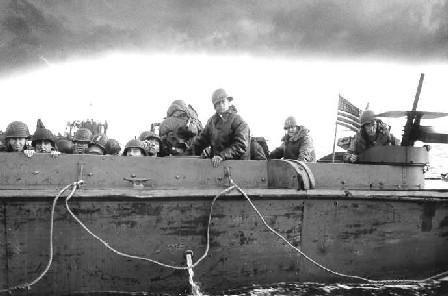
A Coast Guard LCVP on the way to Omaha Beach.
[190416-G-G0000-7006]
The Samuel Chase, accompanying attack transports and LSTs of Assault Group O-1, sailed from England and were joined by five LCI(L)s from Flotilla 10 and 10 craft from the matchbox fleet. All safely arrived in the transport area, and the Chase's anchor dropped into the channel at 3:15 a.m. The remaining LCI(L)s from Flotilla 10 were dispersed with the other Omaha assault groups and made the voyage across without incident.
All was quiet on the Samuel Chase when the order to "lower away" was given at 5:30 a.m. All that could be heard was the squeaking of the davits and the quiet whispers of the soldiers as they loaded into the LCVPs. The landing craft were lowered into the swells and headed towards France. Here too, as at Utah, they were well away from the coast and subjected to the unsheltered waters of the Channel. All of the Chase's boats got away without incident but seasickness soon overtook most of the soldiers. They had to go through 11 miles of rough seas, strong currents, and minefields. They soon passed the battleships on their journey in and the soldiers winced as the 14-inch guns fired. Ernest Hemingway, author, in one of the LCVPs, later wrote about the men, "Under their steel helmets they looked like pikemen of the Middle Ages to whose aid in battle had suddenly come some strange and unbelievable monster."
Imlay, as the deputy assault commander of the Coast Guard's Omaha Assault Group O-1, went in with LCI(L)-87 to act as a traffic policeman and to ensure that all went according to plan. He cajoled, threatened and encouraged the ships and craft all up and down the waters off the Omaha assault area all morning, making sure that they landed on the correct beaches at their appointed times.
My eyes were glued to the boat coming in next to ours, and on the water in between, boiling with bullets from hidden shore emplacements, like a mud puddle in a hailstorm. It seemed impossible that we could make it in without being riddled.
A Coast Guard coxswain describes the waters off Omaha Beach on 6 June 1944.
The landing craft formed up for the assault on areas code-named Easy Red and Fox Green on the eastern end of the assault area and their colorful code-names belied their deadly nature. These landing craft, manned by Coast Guard and Navy crews, carried the troops of the 1st Division, otherwise known as the "Big Red One." This was to be the Big Red One's second journey to France but no bands greeted them this day as they had for their first arrival during World War I.
Five-thousand yards from the beach, LCTs released amphibious tanks which, as at Utah, were to "swim" through the water and land one minute before H-Hour. But their canvas sides caved in under the heavy seas and those destined to support the eastern landings began to founder. Rescue-craft CGC-3 rescued the crew of one tank but most of the sinking-steel coffins took their crews with them straight to the bottom. Only five out of 32 amphibious tanks made it ashore to the Coast Guard's assault area.
The LCVPs from the assault transports circled 4,000 yards off the beach at the line of departure, shepherded by the control vessels, as they waited for H-Hour to proceed to their assigned landing areas. These small boats brought the first waves ashore. The LCIs and LSTs landed their troops and equipment later. The rescue cutters circled here as well.
The Coast Guard coxswains anxiously awaited the signal to move in. The beaches that comprised these two landing areas stretched for 3,000 yards. There were six boats for each area and every boat had a specific landing point within those 3,000 yards. Besides having to keep all of that straight, the coxswains also had a timetable to keep.
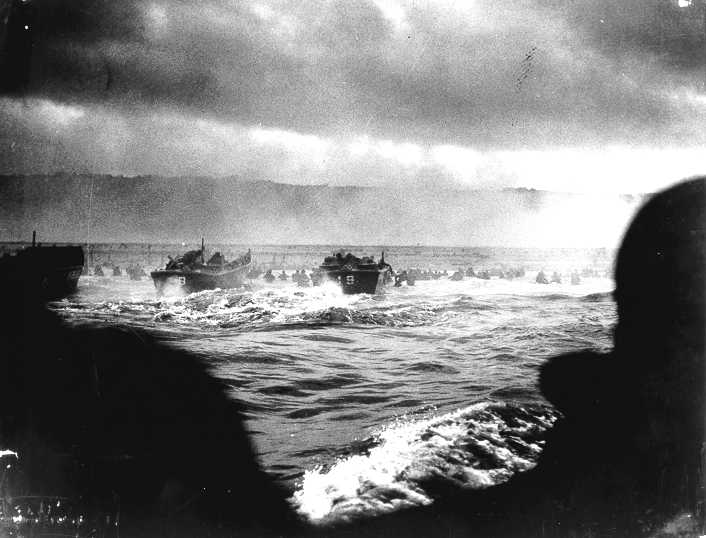
LCVPs from the Chase approach Omaha Beach under fire.
[190419-G-G0000-7001]
After the first wave of eight assault battalions landed, the second wave carrying 14 demolition teams landed a mere two minutes later. They had 30 minutes to blow up the exposed obstacles so that later assault waves would have clear channels. Then a new assault wave would arrive every 10 minutes until 9:30 a.m. It was a well-choreographed affair, ripe for problems sure to be brought out by the "fog and friction" of war.
At the appointed time, the crews of the 12 boats of the first wave of Assault Group O-1, under the command of Coast Guard Lieutenant, Junior Grade James V. Forrestal, formed up and headed towards France. The cliffs behind the beach appeared menacingly through the early-morning haze as water splashed into the open craft. When they closed to within 500 yards of the beach the Germans opened fire with machine guns, mortars and heavy artillery. The fire was heavy and accurate. Bullets struck the landing craft with metallic pings and columns of water shot high into the air as they raced towards shore. One Coast Guard coxswain noted, "We knew we were going to catch hell when we saw machine-gun fire spraying the water before us."
The bow doors dropped as soon as the craft touched bottom on sand bars well away from the shore line. The soldiers disembarked into three feet of water and ran for the shore. Intense enemy fire cut down many as they jumped off. Others drowned after being wounded in the surf, weighted down by their heavy packs. Most of the officers were killed, and those troops that actually made it to the beach huddled near the sea wall after a tortuous 400-yard journey across open terrain under fire.
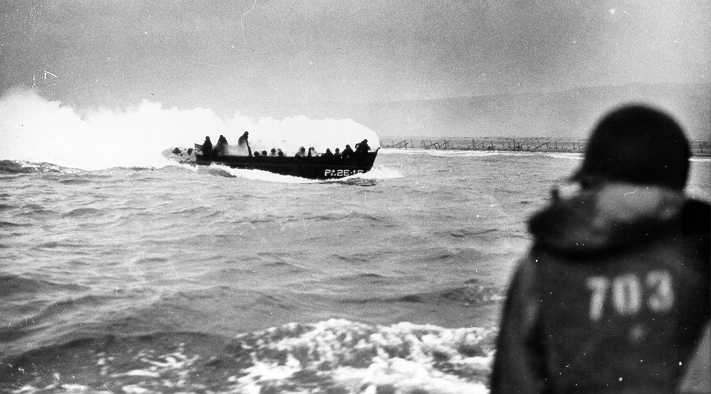
A LCVP from the Chase, approaching Omaha Beach, is drenched in smoke that resulted when a German bullet hit a smoke grenade being carried by one of the soldiers. After discharging his load of troops, the boat's coxswain, Coast Guardsman Delba L. Nivens, assisted by his engineman and bowman, put out the fire safely.
[190419-G-G0000-7002]
The demolition teams fared little better. The Germans killed everyone in two of the 14 teams in minutes, and the rest suffered crippling casualties. The survivors managed to blow five channels clear, but the tide rose too quickly to mark them. By 8 a.m., all of Rommel's obstacles were covered by a blanket of water, invisible to the eye. They would claim many lives during the day, including a number of Coast Guardsmen and their vessels.
As the demolition teams braved enemy fire, the Coast Guard-manned LCVPs from the Samuel Chase, carrying 1st Division soldiers, made their way to Easy-Red beach in three waves. As each wave lowered their ramps German machine guns and mortars opened up.
A Coast Guard coxswain said, "You have no idea how miserable the Germans made that beach. From a half mile offshore we could see rows upon rows of jagged obstructions lining the beach ... When our ramp went down and the soldiers started to charge ashore, the (Germans) ... let loose with streams of hot lead which pinged all around us. Why they didn't kill everyone in our boat, I will never know."
Another Coast Guard LCVP skipper said, "My eyes were glued to the boat coming in next to ours, and on the water in between, boiling with bullets from hidden shore emplacements, like a mud puddle in a hailstorm. It seemed impossible that we could make it in without being riddled."
By 8 a.m., the troops on the beach were virtually leaderless and pinned down by heavy, concentrated machine-gun and mortar fire. German 88s continued to pick off landing craft. No troops had penetrated the German defenses and the continuing waves of assault troops began backing up in a huge traffic jam. At 8:30 a.m., the LCIs moved in at their appointed time and added to the confusion.
To save time and avoid the risky journey in through the obstacles many disembarked their troops into smaller landing craft well offshore. One of the instruction manuals given to the crews during training noted, however, that "Hedgehogs, stakes, or tetrahedra will not prevent your beaching provided you go flat out. Your craft will crunch over them, bend them and squash them into the sand and the damage to your outer bottom can be accepted. So drive on."
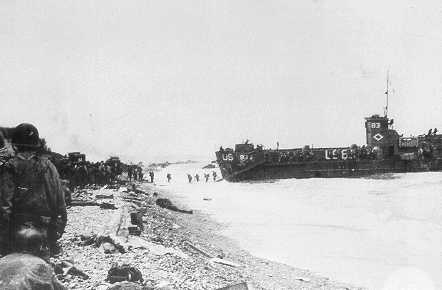
Coast Guard LCI(L)-83 disembarks troops at Omaha Beach, D-Day, 6 June 1944. She struck a mine upon landing and lay disabled on the beach, under enemy fire, until her hull was patched and she was able to get underway.
[190419-G-G0000-7003]
With those comforting words on their minds, a few risked the journey right to the beach and found that, in fact, the obstacles did crumple like paper toys when rammed by an LCI, as long as they were not mined. After observing a few landing craft make it through successfully, many more began charging the beach like knights at a medieval joust. For instance, the LCI(L)-89 rammed its way through the obstacles, grounding at exactly 8:30 a.m., on Easy Red beach. Six minutes later, an 88mm shell penetrated the hull and exploded in the forward troop compartment, wounding six men. The crew backed it off the beach and unloaded the troops into LCVPs from the Chase.
The LCI(L)-85 struck a mine and was hit by at least 25 artillery shells. Its commanding officer stated, "The 88's began hitting the ship, they tore into the compartments and exploded on the exposed deck. Machine guns opened up. Men were hit and men were mutilated. There was no such thing as a minor wound." It returned to the Chase and off loaded the wounded before she sank.

The mortally damaged LCI(L)-85, her decks littered with the dead, lays alongside the transport Samuel Chase. Her crew managed to disembark the survivors before she sank. Note how the censor scratched off the dead man's face.
[190419-G-G0000-7004]
Further to the west the LCI(L)-91 grounded and the troops disembarked. The LCI moved forward as the tide came in and it struck a mined obstacle. The commanding officer backed it off the beach and moved 100-yards west and ordered it in again. The Germans found the range and repeatedly hit the vessel with 88mm artillery fire. One shell exploded in the forward troop compartment and killed everyone there. The ship caught fire and burning men leapt into the water. The crew abandoned the ship and the beached LCI(L)-91 burned all morning. Seven of its Coast Guard crew perished and 11 were wounded.
The LCI(L)-92 with 192 troops aboard, approached the beach shortly after the LCI(L)-91, and the men saw it burst into flames. The crew beached the LCI in the lee of the burning Coast Guard ship in the hope that the smoke from its fire would help cover the landing. The ship grounded near the LCI(L)-91 but the German shells still found their mark. An explosion ripped through the forward compartments and it burst into flame. The crew fought the fire while the disembarking troops were cut down by German machine gun fire. Shells continued to hit the LCI and the fire spread despite the crew's efforts to contain it. They fought to save their ship until 2 p.m. when the order to abandon ship was finally given. Eleven crewmen were wounded that day. The funeral pyres of these two Coast Guard-manned LCIs served as landmarks that day for the incoming craft and German artillery spotters.
Down the beach, the LCI(L)-93 delivered its first load of troops and emerged unscathed but on the second trip grounded on a sand bar off the beach and took 10 direct hits. Thus, in a few minutes, four Coast Guard- manned LCIs were lost after they made it to the beach. Thus Flotilla Ten lost four LCIs that morning, their first losses of the war. Their sacrifice made clear the strength of the German defenses and the bravery of the crews who risked enemy fire to get their troops directly to the beaches.
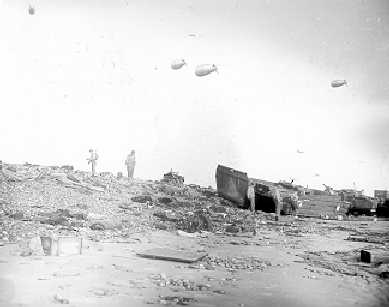
The aftermath debris litters the beaches of Normandy.
[190419-G-G0000-7005]
There were no further losses although two more Coast Guard-manned LCIs were damaged. The LCI(L)-83 struck a mine close to the beach and settled into the shallow water. Later, when the receding tide exposed the punctured hull, the Coast Guard crew patched it and made it back to Great Britain for a complete repair. The LCI(L)-88 was also extensively damaged, but the crew managed to disembark their troops and return to port. But the four Coast Guard-manned LCIs were lost, the only Coast Guard-manned LCIs lost during the entire war.
The Chase launched 15 assault waves and by 11 a.m. all of the 1st Division troops aboard had disembarked. LCTs maneuvered alongside and soon all of their equipment was on the way to the beaches as well. The LCVPs and LCMs returned with casualties who were cared for by the Chase's Public Health Service doctors. Some of the small boats became rescue vessels.
One Coast Guard LCVP skipper said, "We didn't think twice about going to help out a shipmate in distress. Ship spirit is at its best when the enemy is making it tough for us." He had pulled a landing craft to safety while carrying wounded soldiers back to the Chase. Such incidents were common along the shores of Normandy on D-Day.

Two RAF flight crew members from a Mosquito bomber that crashed in the English Channel are rescued by the crew of a Coast Guard 83-foot cutter of Coast Guard Rescue Flotilla One.
[190419-G-G0000-7006]
All in all, it was a successful morning for this Coast Guard-manned ship. But the day was not without loss. Six LCVPs did not return. One impaled itself on an obstacle before it made it to the beach. Four swamped in the heavy surf and one sank after taking a direct hit from a German 88, killing one Coast Guardsman outright. A total of 18 crewmen were missing.
Fortunately, many were alive and had made it to the beach where they huddled with the troops and waited for a chance to get back to their transport. One later reported that after he safely landed his troops a control vessel instructed him to begin offloading waiting LCIs. As he was headed back in with a fresh load of troops "We saw two British landing craft get direct hits by 88s. One of them blew up in a great gust of flame ... (as for us) I really dreaded the thought of facing those machine guns again ... but we beached the troops on dry land. Again they cut loose on us, but this time they hit home. Bullets sprayed into the stern of my boat as I was getting ready to back off. Then my engine conked out." Uninjured, he managed to hitch a ride back to the Chase later in the day.
The matchbox-fleet patrol boats kept busy rescuing survivors along the entire Omaha beachhead and the experience of one of these diminutive wooden-hulled patrol craft typified the role of the cutters that day.
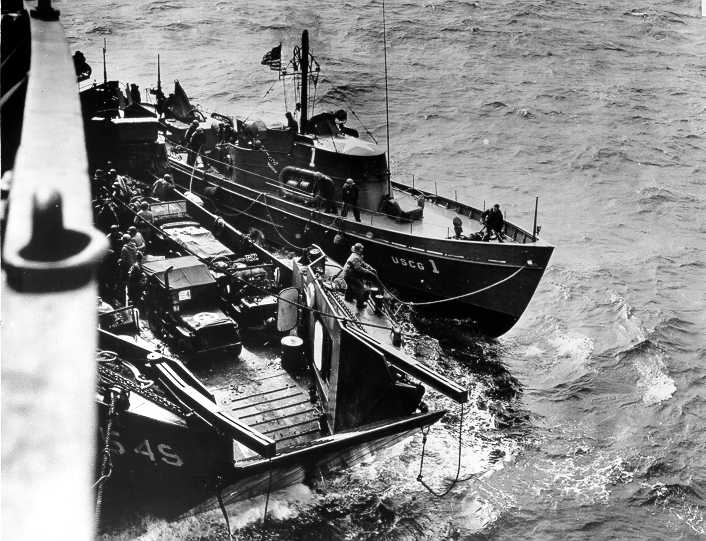
The 83-foot Coast Guard cutter USCG 1 off Omaha Beach on the morning of D-Day, tying up to an LCT and the Samuel Chase. USCG 1 escorted the first waves of landing craft into the Omaha assault area on D-Day morning. Its crew pulled 28 survivors from a sunken landing craft out of the English Channel right off the beaches before 0700, 6 June 1944.
[190419-G-G0000-7007]
The CGC-1 formed up with the Omaha assault force and arrived at its station at 6 a.m. It escorted a group of LCVPs to the beach. Two miles offshore a lookout spotted men from a sunken British LCA in the water and the CGC-1 went to their assistance.
The Coast Guardsmen had to jump overboard and tie lines to the freezing survivors because they were too cold to help themselves aboard. The cutter's crew succeeded in pulling 24 soldiers and four Royal Navy sailors from the Channel. They then sailed back to the transport area and transferred the survivors to the Chase. The CGC-1 then returned to the waters off Omaha. At 9:45 a.m. they recovered 19 survivors from the LCI(L)-91, 14 of whom were part of the LCI's Coast Guard crew and transferred these men to the Chase and once again returned to their station. They spent the better part of the day within 2,000 yards of the beach under enemy machine-gun, mortar and artillery fire. No crewman was injured and the crew returned to Britain unscathed. On the beaches, however, the day was not going well.
Enemy fire was still intense and the naval gunfire support groups could not fire on targets because they were unable to contact the spotters on the beaches, most of whom had been killed or had their radio equipment damaged. British and American destroyers took the initiative and moved into point blank range and opened fire. Only a few hundred yards off the beaches they plastered the pillboxes, mobile 88s and machine-gun positions.
With their assistance the infantry slowly silenced the Germans, and through sheer force of will, manpower, and a few brave officers and men who rallied the troops, the Americans moved inland as the afternoon wore on. The momentum increased as obstacles were cleared and paths through them marked so that more landing craft could beach. The traffic jam cleared as Imlay sailed among the incoming craft, checked their manifests, ranked them according to their cargoes, and sent them in as time and space permitted.
The situation stabilized by 8 p.m. to the point that Fritzche turned command over to Imlay and returned to Great Britain. As the Allies had no ports in which to deliver supplies and reinforcements, the British, with the assistance of some Coast Guard officers, had devised a series of artificial harbors, some of which were named mulberries. These were set up around the American and British beaches. They were designed to handle 12,000 tons of supplies per day and would also allow LSTs to unload from them directly, well away from the beaches. Imlay was assigned as the port director for the Omaha mulberry which was soon handling as much traffic as most of the larger ports of the world. The Allies also devised a series of blockship breakwaters, named "gooseberries," to handle even more supplies necessary to supply the five divisions.
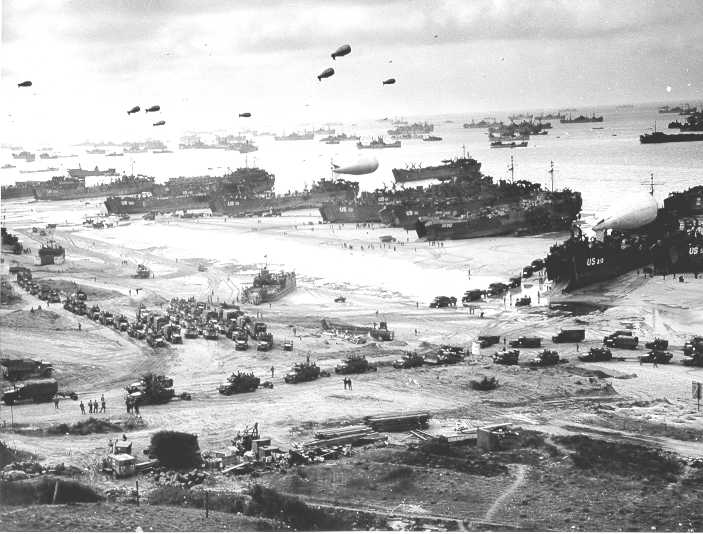
Omaha Beach secured. A panoramic view of the Omaha beachhead after it was secured, sometime around mid-June 1944, at low tide. The Coast Guard-manned LST-262 is the third beached LST from the right, one of 10 Coast Guard-manned LSTs that participated in the invasion of Normandy, France, in June, 1944.
[190419-G-G0000-7008]
The Bayfield continued to operate as the command ship for Utah and operated off the French coast for 19 days after D-Day. Its surgeons remained busy caring for the wounded throughout that time, and luckily the ship survived the nightly German bombing attacks, which began the night of June 6. The other transports and Coast Guard-manned landing craft continued to bring reinforcements and supplies to France and return with wounded and prisoners. One, LST-261, made 53 crossings in the days following D-Day. Once the operation was over they were on their way to the Pacific, ready to destroy the Empire of Japan.
The Germans committed their panzer divisions too late to throw the Allies back into the sea as the Allied deceptions had convinced them that the Normandy landings were just a feint for the "real" invasion at Pas de Calais. Hitler ordered the powerful Fifteenth Army to stay there until well after the Allies secured their foothold at Normandy. Operation Neptune officially ended on June 29 with the liberation of Cherbourg. The Allies' breakout from the Normandy beachhead occurred seven weeks after D-Day, and Lieutenant General George S. Patton Jr.'s newly constituted Third Army raced for Paris. The liberation of Europe was at hand. The Allied forces had pooled their resources and accomplished what many believed could not be done. They successfully invaded Hitler's Fortress Europe and sealed the fate of the Third Reich.
The Coast Guard's role during that invasion has often been overlooked. Nevertheless the service deserves more than a nod of appreciation from those who now enjoy the fruits of the Allied victory. Coast Guardsmen manned 99 warships and large landing vessels for Operation Neptune and dozens of smaller landing craft. The Coast Guard lost more vessels that day than on any single day during its history, mute testimony to the ferocity of the German defenders and the bravery of the crews who took the infantry right to the enemy's doorstep. Eighteen Coast Guardsmen paid the ultimate price that day as well, while 38 more were seriously wounded. There were more casualties to come that summer from mines, torpedoes and attacks by the Luftwaffe as the ships sailed the English Channel carrying supplies and reinforcements and returning with prisoners of war and wounded GIs.
Carrying out the Coast Guard's time-honored task of saving lives, albeit under enemy fire on a shoreline thousands of miles from home, the cutters of Rescue Flotilla One saved more than 400 men on D-Day alone and by the time the unit was decommissioned in December, 1944, they had saved 1,438 souls. As at North Africa, Sicily, Italy and throughout the Pacific, the Coast Guard was instrumental to the invasion's success. An admirable record for the United States' oldest continuous sea-going service.
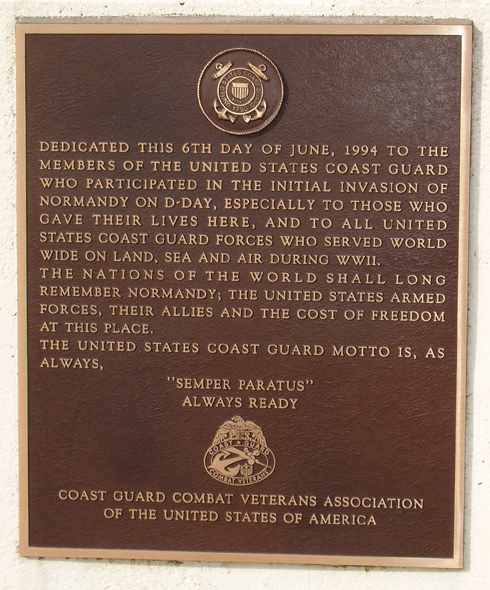
A memorial plaque in England.
[190419-G-G0000-8001]